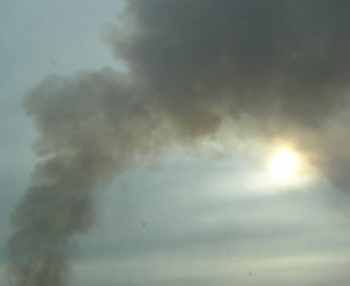
Publisher:
Bonnie King
CONTACT:
Newsroom@Salem-news.com
Advertising:
Adsales@Salem-news.com

~Truth~
~Justice~
~Peace~
TJP
Aug-28-2006 22:23

 TweetFollow @OregonNews
TweetFollow @OregonNews
DEQ Plans No Changes to Oregon Field Burning Regulations
Salem-News.comContrary to recent news reports, the Oregon Department of Environmental Quality has no plans to change the field burning program that minimizes smoke impacts from burning grass seed fields in the Willamette Valley.
 Salem-News.com |
(SALEM) - A proposed new federal standard to further limit the amount of air pollution allowed will have a big impact on Oregon, but not directly on field burning.
The field burning program is operated by the Oregon Department of Agriculture.
The U.S. Environmental Protection Agency has proposed to tighten the standard for fine particulate because new evidence shows that these very small particles are trapped deep in the lungs where they do more damage than previously thought.
The proposed EPA standard would affect winter burning such as wood stoves.
DEQ has monitored air pollution at levels near the standard in over a dozen Oregon communities, and recent monitoring shows that at least two communities – Klamath Falls and Oakridge – will likely violate the new standard when EPA finalizes it later this year.
“The biggest source of fine particle pollution in Oregon is older woodstoves.” according to Andy Ginsburg, DEQ’s Air Quality Administrator.
On cold winter days, smoke from wood burning can get trapped under an inversion where it builds up to unhealthy levels.
Smoke from diesel engines, industrial boilers and other sources also contribute to the problem, along with particles formed by reactions in the atmosphere.
“DEQ’s main strategy to reduce fine particulate pollution is to help people with older high-emitting woodstoves replace them with cleaner new woodstoves or other types of heat,” Ginsburg said.
The goal of the existing field burning program is to minimize smoke impacts on urban areas where the smoke can cause irritation, haze and health risks.
“Field burning is a minor contributor to the problem addressed by EPA’s proposed new standard,” said Ginsburg,” because it generally does not occur in the winter or near areas that are at risk of violations.
Still, it is important to minimize exposure to any type of smoke because the burning process releases toxic air pollutants.”
Under the program, the amount of field burning in Oregon has been reduced from over 300,000 acres a year in the 1960s to no more than 65,000 acres today.
The average number of acres burned annually is approximately 50,000.
Research is underway to develop new alternatives for disposing of the straw, including technologies developed by Oregon Universities to covert the waste into biofuels.
Articles for August 27, 2006 | Articles for August 28, 2006 | Articles for August 29, 2006
Quick Links
DINING
Willamette UniversityGoudy Commons Cafe
Dine on the Queen
Willamette Queen Sternwheeler
MUST SEE SALEM
Oregon Capitol ToursCapitol History Gateway
Willamette River Ride
Willamette Queen Sternwheeler
Historic Home Tours:
Deepwood Museum
The Bush House
Gaiety Hollow Garden
AUCTIONS - APPRAISALS
Auction Masters & AppraisalsCONSTRUCTION SERVICES
Roofing and ContractingSheridan, Ore.
ONLINE SHOPPING
Special Occasion DressesAdvertise with Salem-News
Contact:AdSales@Salem-News.com

googlec507860f6901db00.html



Terms of Service | Privacy Policy
All comments and messages are approved by people and self promotional links or unacceptable comments are denied.
[Return to Top]
©2025 Salem-News.com. All opinions expressed in this article are those of the author and do not necessarily reflect those of Salem-News.com.